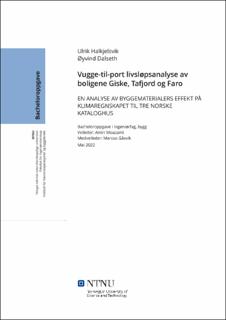| dc.contributor.advisor | Moazami, Amin | |
| dc.contributor.advisor | Gåsvik, Marcus | |
| dc.contributor.author | Halkjelsvik, Ulrik | |
| dc.contributor.author | Dalseth, Øyvind | |
| dc.date.accessioned | 2022-07-07T17:20:19Z | |
| dc.date.available | 2022-07-07T17:20:19Z | |
| dc.date.issued | 2022 | |
| dc.identifier | no.ntnu:inspera:112300464:112301128 | |
| dc.identifier.uri | https://hdl.handle.net/11250/3003621 | |
| dc.description.abstract | Som en stor klimapåvirker, har byggenæringen et stort ansvar når det kommer til videre utvikling.
Det å ta klimabeviste materialvalg vil være en essensiell del av industriens reduksjon i
klimagassutslipp. For å nå de globale målene om å stoppe globaloppvarming, må bedriftene i
byggebransjen ta steg i riktig retning, når det kommer til miljøbevisste prosjekteringsvalg.
Oppgaven tar for seg tre norske kataloghus fra Byggmann og setter opp et klimagassregnskap ved
bruk av OneClick LCA. Ved å gjennomføre en livssyklusanalyse av den originale prosjekteringen, kan
potensielle klimavennlige alternativ sammenlignes og vurderes. Oppgaven fokuserer på
livssyklusfasene A1 til A3 (produktfasen) og A4 (transport til byggeplass). Fasene videre er ikke tatt
med i oppgavens klimagassregnskap. Resultatet er derfor en refleksjon av bygningenes
klimapåvirkning fra vugge-til-port. Resultatene fra den originale løsningen viser at norske
eneboliger, primært konstruert i tre, har gode utgangspunkt når det kommer til klimagassutslipp i
livssyklusfasene A1 til A4. Boligene hadde materialalternativ som kunne redusere utslippet av CO2e
med rundt 10% for alle tre husene. Her ble det gjort materialendringer på grunn og fundament ved
å bytte ut betongen med lavkarbonbetong. Det ble gjort et forsøk i å endre så mye
konstruksjonsvirke som mulig med I-bjelker, men denne prosjekteringsendringen endte med en
økning i klimagassutslipp med ca. 4 %. Transportavstander ble også endret for å simulere bruk av
lokale leverandører. Transportavstandene som ble brukt i livssyklusanalysen var regionale
gjennomsnitt beregnet av OneClick. Ved å simulere bruk av lokaleleverandører kunne det totale
utslippet reduseres med et gjennomsnittlig 1,35%.
Fra et helhetlig perspektiv, var resultatet fra materialendringene en betydelig reduksjon i
klimagassutslipp. Tiltakene er realistiske og vil resultere i mer klimavennlige bygninger. Videre vil
det være interessant å utforske en full livssyklusanalyse av bygningene, fra vugge-til-grav. | |
| dc.description.abstract | As a major contributor to climate change, the construction industry has a big responsibility when it
comes to further development. Climate-friendly material choices will be an essential part of the
industry’s reduction in greenhouse gas emissions. To achieve the global goals of stopping global
warming, companies must take steps in the right direction when it comes to environmentally
conscious design choices.
The thesis deals with three Norwegian catalog houses from Byggmann and sets up a greenhouse gas
account using OneClick LCA. By conducting a life cycle analysis of the original design, potential
climate-friendly alternatives can be compared and assessed. The thesis focuses on the life cycle
phases A1 to A3 (product phase) and A4 (transport to construction site). Later phases are not included
in the thesis’ greenhouse gas accounts. The result is therefore a reflection of the buildings' climate
impact from cradle-to-gate. The results from the original design show that Norwegian detached
houses, primarily constructed of wood, have good starting points when it comes to greenhouse gas
emissions in the life cycle phases A1 to A4. The buildings had material alternatives that could reduce
CO2 emissions by around 10% for all three houses. Here, material changes were made to the plates
and foundation by replacing the concrete with low-carbon concrete. An attempt was made to change
as much structural timber as possible with I-beams, but this design change ended with an increase in
greenhouse gas emissions of about 4%. Transport distances were also changed to simulate the use of
local suppliers. The transport distances used in the life cycle analysis were regional averages provided
by OneClick. By simulating the use of local suppliers, the total emissions could be reduced by an
average of 1.35%. From a holistic perspective, the result of the material changes shows significant
reduction in greenhouse gas emissions. The measures are realistic and will result in more climatefriendly buildings. Furthermore, it will be interesting to explore a full life cycle analysis of the
buildings, from cradle-to-grave. | |
| dc.language | nob | |
| dc.publisher | NTNU | |
| dc.title | Vugge-til-port livsløpsanalyse av boligene Giske, Tafjord og Faro | |
| dc.type | Bachelor thesis | |
